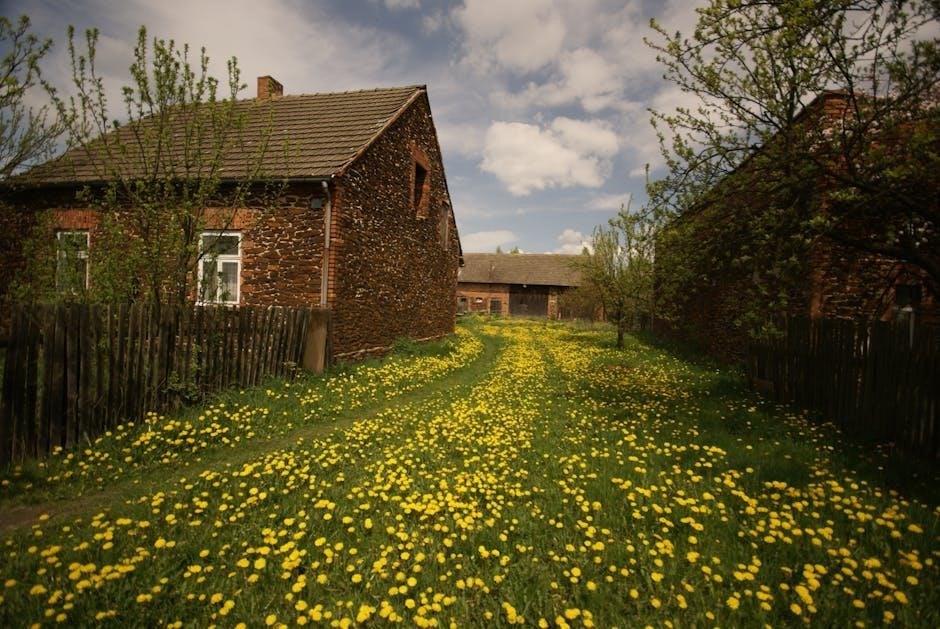“Go Tell It on the Mountain” is a powerful African-American spiritual compiled by John Wesley Work Jr․ in 1865․ It celebrates Jesus’ birth with a four-stanza structure and refrain, offering a message of redemption and hope that extends beyond Christmas, influencing cultural and civil rights movements․
1․1 Overview of the Song’s Significance
“Go Tell It on the Mountain” holds profound cultural and spiritual significance as a Christmas carol and hymn of hope․ Compiled by John Wesley Work Jr․, it emerged from African-American spiritual traditions, capturing the essence of redemption and resilience․ Its four-stanza structure, with a repeated refrain, emphasizes the universal message of Christ’s birth․ The song transcends its origins, influencing gospel, civil rights movements, and secular music, becoming a timeless anthem of faith and liberation across generations․
1․2 Historical Context of the Spiritual
“Go Tell It on the Mountain” is rooted in African-American spiritual traditions, emerging during the 19th century․ It reflects the resilience and faith of enslaved communities, using religious themes as a form of resistance․ Compiled by John Wesley Work Jr․ in 1865, the song captures the cultural and spiritual essence of African-American experiences․ Its origins trace back to the struggles and hopes of a marginalized people, making it a powerful symbol of liberation and enduring faith․ The spiritual’s historical context highlights its role as a voice for oppressed communities seeking freedom and redemption․
Historical Background of the Song
“Go Tell It on the Mountain” is an African-American spiritual compiled by John Wesley Work Jr․ in 1865․ Originating as a Christmas gospel, it spread widely through performances by the Fisk Jubilee Singers, becoming a symbol of hope and redemption․ The song’s enduring appeal lies in its powerful message and historical significance, reflecting the cultural and spiritual heritage of its time․
2․1 The Role of John Wesley Work Jr․ in Compiling the Song
John Wesley Work Jr․, a renowned musicologist and educator, played a pivotal role in compiling “Go Tell It on the Mountain” in 1865․ He was instrumental in preserving African-American spirituals, ensuring their legacy endured․ Work transcribed and arranged the song for the Fisk Jubilee Singers, a group that popularized it nationally․ His efforts not only brought the song to a wider audience but also cemented its place in American musical history, highlighting its cultural and spiritual significance․
2․2 Origins of the Song as an African-American Spiritual
“Go Tell It on the Mountain” emerged as a powerful African-American spiritual during the slavery era․ Created by enslaved individuals, it reflects their deep faith and resilience․ The song’s authorship remains unknown, a common trait of spirituals, which were often communal creations․ Its call-and-response structure and rhythmic cadence resonate with African musical traditions․ Passed down orally before being transcribed, it became a testament to the enduring cultural and spiritual heritage of African-Americans, symbolizing hope, freedom, and the promise of liberation․
2․3 The Song’s Evolution Over Time
Over the years, “Go Tell It on the Mountain” evolved from a simple spiritual to a celebrated hymn․ Initially passed down orally, it was first transcribed by John Wesley Work Jr․ in 1865․ The song gained popularity in the late 19th century through African-American congregations․ In the 20th century, it became a staple in gospel music, with artists like Mahalia Jackson popularizing it․ Today, it is performed in various styles, from traditional to contemporary, ensuring its timeless appeal and enduring cultural significance across generations and musical genres․
Structure and Lyrics of “Go Tell It on the Mountain”
The song features a four-stanza structure with a repeating refrain, creating a call-and-response rhythm․ Its simple, powerful lyrics emphasize storytelling and spiritual celebration, resonating deeply with listeners․
3;1 The Four-Stanza Structure and Refrain
The song is structured into four stanzas, each followed by a refrain that reinforces the message․ The refrain, “Go tell it on the mountain,” serves as a repetitive, unifying element․ Each stanza builds on the narrative of Jesus’ birth, emphasizing key biblical events․ The structure creates a sense of progression, while the refrain invites communal participation, making it accessible and memorable․ This format has contributed to its enduring popularity in both religious and cultural contexts, ensuring its message resonates across generations․
3․2 Biblical References in the Lyrics
The lyrics of “Go Tell It on the Mountain” are deeply rooted in biblical narratives․ The song references the town of Bethlehem, the Virgin Mary, and the birth of Jesus Christ, aligning with the Nativity story in Luke 2․ It also alludes to the shepherds and angels, emphasizing the divine announcement of Jesus’ birth․ These references ground the song in scripture, making it both a celebration of the Nativity and a call to share the Good News․ The biblical themes reinforce the song’s spiritual and evangelical purpose․
3․4 The Universal Message of Redemption
The song conveys a universal message of redemption, emphasizing hope and liberation․ It extends beyond the Nativity story, offering a powerful narrative of divine deliverance and freedom․ The lyrics resonate with themes of salvation and the triumph of faith over adversity, making it relatable to diverse audiences․ The call to “go tell it on the mountain” symbolizes sharing this message of redemption with the world․ This universal appeal has allowed the song to transcend cultural and generational boundaries, speaking to the human spirit’s longing for hope and liberation․

Cultural Significance of the Song
“Go Tell It on the Mountain” is a spiritual anthem that influenced the Civil Rights Movement and inspired gospel, blues, and secular music, uniting cultures and generations with its message of hope, freedom, and resilience, becoming a cultural cornerstone․

4․1 Its Role as a Christmas Carol
“Go Tell It on the Mountain” is a beloved Christmas carol that combines spiritual roots with festive joy, celebrating the birth of Jesus Christ․ Its uplifting melody and narrative connect the divine message of salvation to the hope of freedom, resonating deeply during the holiday season․ The song transcends traditional Christmas carols by blending African-American spiritual traditions with the Nativity story, making it a unique and powerful addition to holiday celebrations worldwide․ Its adaptability to various musical styles has ensured its enduring popularity as a Christmas hymn․
4․2 Impact on the Civil Rights Movement
“Go Tell It on the Mountain” played a significant role in the Civil Rights Movement, serving as a motivational anthem for activists․ Its themes of liberation and hope resonated deeply with those fighting for racial equality․ The song’s message of resilience and divine justice inspired protesters during marches and sit-ins․ Leaders like Martin Luther King Jr․ often referenced its spiritual power, using it to unite and strengthen communities in their struggle for freedom․ Its influence remains a testament to the power of music in driving social change․
4․3 Influence on Gospel and Secular Music
“Go Tell It on the Mountain” has profoundly influenced both Gospel and secular music․ Its powerful message and emotive melody have inspired countless artists, from Gospel legends like Mahalia Jackson to secular performers like Dolly Parton․ The song’s adaptable structure has allowed it to transcend genres, blending seamlessly into country, blues, and even contemporary styles․ Its themes of hope and redemption continue to resonate, making it a timeless piece that bridges musical and cultural divides, ensuring its relevance across generations and genres․

Notable Performances and Recordings
The song has been memorably performed by artists like Peter, Paul and Mary, whose harmonious rendition brought it to a wider audience; Aretha Franklin’s soulful version highlighted its emotional depth․ Modern artists like Pentatonix have also covered it, blending a cappella with contemporary styles․ These performances showcase the song’s enduring appeal and versatility across musical genres․
5․1 Mahalia Jackson’s Iconic Version
Mahalia Jackson’s powerful rendition of Go Tell It on the Mountain is widely regarded as one of the most iconic recordings․ Her soulful, emotive voice brought depth and passion to the song, capturing its spiritual essence․ Recorded in 1947 for Apollo Records, her version remains a benchmark, blending gospel fervor with a joyful celebration of faith․ Jackson’s interpretation not only popularized the song but also elevated its status as a Christmas classic, ensuring its enduring presence in holiday playlists and worship services worldwide․

5․2 Dolly Parton’s Adaptation
Dolly Parton’s adaptation of Go Tell It on the Mountain brings a unique country-bluegrass flavor to the classic spiritual․ Recorded in 1990 for her album Home for the Holidays, Parton’s version blends her signature powerful vocals with a lively instrumental arrangement․ Her interpretation maintains the song’s spiritual core while infusing it with a fresh, rootsy energy․ Parton’s rendition not only honors the song’s tradition but also introduces it to new audiences, showcasing its versatility and enduring appeal across musical genres․
5․3 Modern-Day Performances and Covers
Modern-day performances of Go Tell It on the Mountain showcase its timeless appeal․ Artists like Pentatonix and NEEDTOBREATHE have reimagined the song with a cappella and rock-infused arrangements, respectively; For King & Country’s energetic rendition blends Christian pop with a stadium-ready sound․ These contemporary interpretations highlight the song’s adaptability while preserving its spiritual essence․ Digital platforms have further amplified its reach, with viral covers and virtual performances keeping the hymn relevant in the 21st century, ensuring its message resonates with new generations․

Theological Themes in the Song
The song emphasizes the Nativity of Jesus, highlighting divine redemption and salvation․ It calls believers to share the Gospel, reflecting themes of hope, faith, and spiritual liberation․
6․1 The Nativity of Jesus Christ
The song “Go Tell It on the Mountain” deeply reflects the Nativity of Jesus Christ, recounting the birth of Jesus in Bethlehem․ The lyrics emphasize the divine announcement to the shepherds and the angelic choir, highlighting the miraculous nature of Jesus’ birth․ This theological theme underscores the song’s celebration of God’s redemption plan, making it a powerful expression of Christian faith․ The Nativity story is central to the song’s message, linking it to the broader narrative of salvation and hope․
6․2 The Call to Evangelism and Mission
The song “Go Tell It on the Mountain” embodies a powerful call to evangelism and mission․ It urges believers to actively share the news of Jesus’ birth and redemption, emphasizing the importance of spreading God’s message․ The lyrics inspire both personal proclamation and collective mission, reflecting the joy and urgency of sharing the Gospel․ This theme aligns with the broader Christian narrative of spreading hope and salvation, making the song a timeless exhortation to faith and action, inspiring countless to embrace their missionary calling․
6․3 Themes of Hope and Resilience
“Go Tell It on the Mountain” resonates deeply with themes of hope and resilience, rooted in its historical context as a African-American spiritual․ The song’s message of redemption and liberation offers comfort to those enduring hardship, reflecting the struggles of slavery and segregation․ Its refrain of joy and deliverance inspires perseverance, embodying the spirit of overcoming adversity․ The lyrics symbolize freedom and the promise of a better future, making it a powerful anthem of hope for generations facing challenges and seeking strength in faith and community․

Educational and Liturgical Uses
“Go Tell It on the Mountain” is widely used in worship services and educational settings, teaching historical and theological significance while inspiring cultural and spiritual connection․

7․1 Use in Worship Services
“Go Tell It on the Mountain” is a cherished hymn in worship services, often sung during Christmas and special celebrations․ Its powerful lyrics and uplifting melody inspire congregations to reflect on the Nativity and the call to share the Gospel․ Many churches incorporate it into their liturgy, using it as a joyful expression of faith and redemption․ The song’s universal message resonates deeply, making it a unifying element in diverse worship traditions․

7․2 Incorporation into Holiday Celebrations
“Go Tell It on the Mountain” is a beloved Christmas carol that enriches holiday celebrations worldwide․ Its joyful melody and message of redemption resonate during festive gatherings, church services, and community events․ The song’s uplifting spirit creates a sense of unity and celebration, making it a staple in many holiday traditions․ Its adaptation into various musical styles ensures its appeal across diverse cultures, fostering a connection to the true meaning of the season․
7․3 Teaching the Song in Educational Settings
“Go Tell It on the Mountain” is a valuable educational tool, used to teach students about African-American spirituals, their historical context, and cultural significance․ In music classes, it introduces learners to gospel harmonies and rhythmic patterns․ The song also serves as a literary text, exploring themes of faith and freedom․ Educators incorporate it into social studies to highlight its role in the Civil Rights Movement․ Its universal message of hope and resilience makes it a powerful resource for interdisciplinary learning․

Modern Adaptations and Interpretations
The song has been reimagined in various genres, from pop to rock, showcasing its timeless appeal․ Contemporary artists blend traditional gospel with modern styles, creating fresh energy while preserving its spiritual core․
8․1 Contemporary Musical Arrangements
Modern musicians have reinterpreted “Go Tell It on the Mountain” with fresh instrumentation and styles․ From pop to rock, artists incorporate electronic beats, orchestral elements, and jazz improvisations, breathing new life into the classic hymn․ These arrangements maintain the song’s spiritual essence while appealing to contemporary audiences․ Collaborations between gospel choirs and secular artists highlight its universal appeal․ The fusion of traditional and modern sounds ensures the song remains relevant, bridging generations and genres seamlessly․
8․2 Cultural Fusion in Performances
Contemporary performances of “Go Tell It on the Mountain” often blend diverse cultural traditions, creating unique musical experiences․ Artists infuse the hymn with Latin rhythms, Celtic folk instruments, or African drumming, showcasing its adaptability․ These fusions highlight the song’s universal message while celebrating cultural diversity․ Collaborations between global artists further enrich the piece, demonstrating how its spiritual essence transcends boundaries․ Such performances not only honor its roots but also introduce the song to new audiences, ensuring its relevance in a multicultural world․
8․3 The Song’s Relevance in the Digital Age
“Go Tell It on the Mountain” remains a vital part of modern culture, thriving in the digital age․ Streaming platforms and social media have expanded its reach, allowing global audiences to engage with the song․ Virtual choirs and online worship services often feature the hymn, fostering a sense of community․ Digital collaborations and remixes introduce the song to younger generations, ensuring its timeless message of hope and redemption continues to resonate․ Its accessibility and enduring appeal make it a cherished piece in today’s interconnected world․
“Go Tell It on the Mountain” endures as a powerful symbol of faith, resilience, and cultural identity, continuing to inspire generations through its timeless message and universal appeal․
9․1 The Enduring Legacy of “Go Tell It on the Mountain”
“Go Tell It on the Mountain” remains a cornerstone of spiritual and cultural heritage, transcending generations with its powerful message of hope and redemption․ Originating as an African-American spiritual, the song has evolved into a global anthem, inspiring countless adaptations across music genres․ Its themes of resilience and faith continue to resonate, making it a timeless emblem of unity and cultural identity․ The song’s legacy endures, bridging past and present, and reinforcing its universal appeal and historical significance․
9․2 Its Continued Influence on Music and Culture
“Go Tell It on the Mountain” continues to shape music and culture, inspiring artists across genres․ Its powerful melody and poignant lyrics have influenced gospel, blues, and secular music, creating a cultural bridge․ The song’s universal themes of hope and redemption resonate globally, fostering unity and inspiring new adaptations․ Its impact is evident in modern performances, holiday celebrations, and educational settings, ensuring its relevance in contemporary society while preserving its historical roots and emotional depth․
9․3 Final Thoughts on the Song’s Universal Appeal
“Go Tell It on the Mountain” endures as a testament to music’s power to unite and inspire․ Its universal themes of hope, redemption, and joy transcend cultural boundaries, resonating with diverse audiences․ The song’s adaptability across genres and generations underscores its timeless appeal․ Whether sung in churches, homes, or public spaces, its message of love and freedom continues to uplift humanity, ensuring its place as a cherished hymn for centuries to come․

Leave a Reply